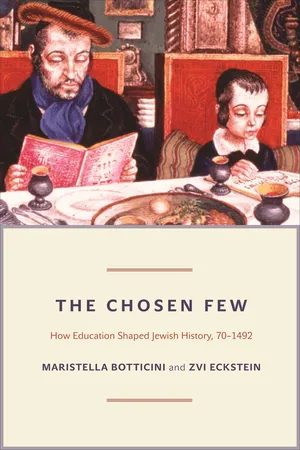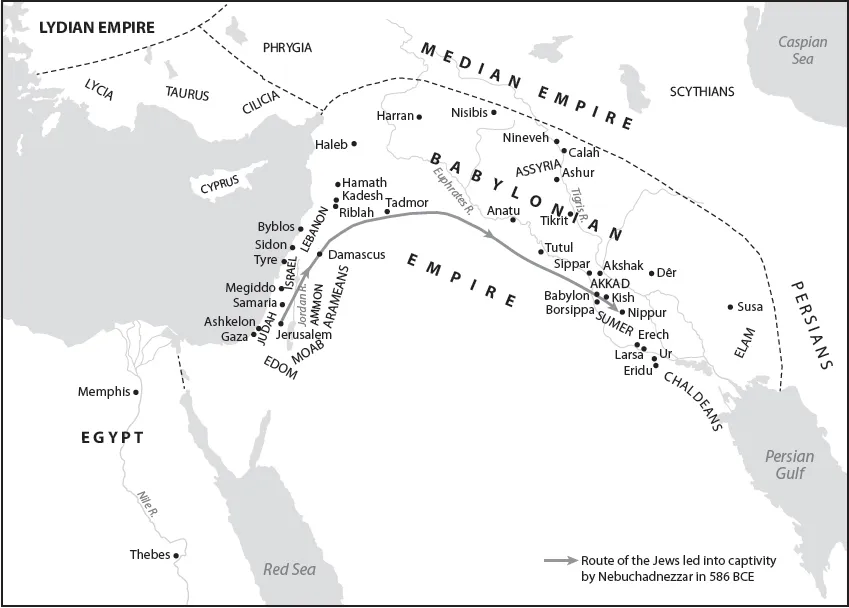![]()
CHAPTER 1
70 CE–1492
HOW MANY JEWS WERE THERE, AND WHERE AND HOW DID THEY LIVE?
Ours is not a maritime country; neither commerce nor the intercourse which it promotes with the outside world has any attraction for us. Our cities are built inland, remote from the sea, and we devote ourselves to the cultivation of the productive country.
—Flavius Josephus, c. 96 CE
The Route of the Jewish Rādhānite merchants, who speak Arabic and Persian and Rūmī (Greek), and Ifranjī (Latin) and Andalusī (Spanish) and Slavic. They travel from [the] east to [the] west and from the west to the east, by land and by sea…. They transport from China…. sometimes they turn to Constantinople with their merchandise …; sometimes they travel with it to the king of Firanja (Frankish Kingdom) and sell it there. And if they wish, they transport their goods from Firanja … to Baghdad, and from there … to Sind and to Hind and to China.
—Ibn Khordadbeh, c. 850
SPIN A GLOBE, WAIT FOR IT TO STOP, THEN PUT YOUR FINGER ON THE first place you see. A Jewish community is likely to have lived there, in the ancient past or in recent times. Jews have lived in so many places, in such vastly diverse political, economic, and religious environments, that their history is difficult to summarize in multiple volumes, much less a single chapter. Familiarity with the basic facts of Jewish history from the destruction of the Second Temple in Jerusalem to the mass expulsion of the Jews from the Iberian Peninsula is critical, however, to understanding why the Jewish people came to share certain characteristics. In this chapter, we therefore illustrate and examine Jewish population and occupational trends.
For centuries, Jews lived in Judea, Samaria, and the Galilee—the three main regions in the Land of Israel. The center of Jewish religious practice was the Temple in Jerusalem, erected during the tenth or ninth century BCE. In 586 BCE, the Babylonian army demolished it under the leadership of King Nebuchadnezzar II during the military campaign to expand his empire and deported a number of Jews from Judea to Mesopotamia, particularly to its capital, Babylon (map 1.1). This marked the end of the First Temple period.1
The Babylonian exile brought a number of pivotal changes, including the emergence of the central role of the Torah in Jewish life and the rise of scribes and sages as Jewish leaders. The Written Torah consisted of the Five Books of Moses (Genesis, Exodus, Leviticus, Numbers, and Deuteronomy).2 In 538 BCE, the Persian emperor Cyrus, who had conquered Mesopotamia, issued an edict permitting the Jews to return to Judea and rebuild the Temple in Jerusalem. Nearly 40,000 Jews returned to the Land of Israel in subsequent waves of migrations. A large number of Jews, though, remained in Mesopotamia, which in the following centuries hosted one of the largest and most prominent Jewish communities in the Diaspora—that is, outside the Land of Israel.
The reconstruction of the Temple took about twenty years; its dedication in 515 BCE initiated the period of the Second Temple.3 In the following four centuries, the Land of Israel fell under the control of the Hellenistic ruler Alexander the Great, the Ptolemaic dynasty ruling over Egypt, and the Hellenistic Seleucid dynasty. During this era, especially in the later part, generations of prophets, scholars, and high priests studied, clarified, and supplemented the Written Torah. Their discussions, judgments, and rulings are called the Oral Torah, which together with the Written Torah would form the backbone for the entire body of Jewish law (halakha) in the subsequent centuries. The halakha sanctioned what a Jew could and could not do, as well as what a Jew should and should not do, in every aspect of daily life—from the observance of religious and ritualistic duties to marital relations, from behavior within the community to civil and criminal law.
The Greeks granted the Jews a kind of communal autonomy as well as religious freedom, which was interrupted by a persecution around 167 BCE, which in turn precipitated a Jewish revolt. From 140 BCE, Judea enjoyed a period of freedom for almost a century under the Hasmonaean dynasty (map 1.2).4 In 63 BCE, Roman influence and then dominion over the region began. Rome, however, granted the Jews religious autonomy and bestowed on them some judicial and legislative rights through the Sanhedrin in Jerusalem, which functioned as a parliament, a high court, and an academy (yeshiva).
Map 1.1. The Babylonian empire of Nebuchadnezzar II (604–562 BCE). Source: Redrawn and adapted from Beek (1962).
Map 1.2. The Land of Israel in the first century BCE. Source: Redrawn and adapted from Aharoni et al. (2002). Note: The dashed line shows the borders of the Hasmonaean kingdom of Alexander Yannai (103–76 BCE), who ruled over the Land of Israel during the first century BCE.
The Second Temple period came to a traumatic end in 70 CE. This is when our book starts. The focus is on three periods, each marked by a “historical accident”: the destruction of the Second Temple by the Roman army during the first Jewish-Roman war (also known as the Great Revolt); the rise of Islam during the seventh century, with the subsequent establishment of one of the largest, most urban, and most commercial empires in history; and the Mongol conquest of Mesopotamia and Persia during the early and mid-thirteenth century, which contributed to the collapse of the urban and commercial economy of the Abbasid caliphate. These exogenous events interacted with the internal dynamics of the Jewish religion to shape the unique demographic and economic traits that characterize the history of the Jews before 1500.
FROM JESUS TO MUHAMMAD (1 CE–622): A WORLD OF FARMERS
Who was a Jew during the Second Temple period?5 Up to the destruction of the Second Temple, the daily lives of the Jews were similar to those of non-Jews: they dressed alike, spoke the same local languages (Aramaic, Hebrew, or Greek), and earned their living from the same occupations (mainly farming). As in other religions, including pagan cults, the central feature of Jewish religious life consisted of temple service and ritual sacrifices performed by a small elite of high priests.
Jews differed from pagans in three major ways: they believed in one God; their religious, social, and economic life was shaped by the Torah; and they practiced male circumcision, ate kosher food, and observed the Sabbath.6 During the later part of the Second Temple era (300 BCE–65 CE), Judaism witnessed the emergence of a variety of sects (Sadducees, Pharisees, Essenes, Samaritans, Zealots, Sicarii), increasingly differentiated by their religious norms. Christianity also grew within Judaism in the early decades of the first century. All of these Jewish sects shared the three features that distinguished them from pagan cults. Hence, up to 70 CE, all of these people are considered to be Jews. Later, especially after 200, the answer to “who is a Jew” changed drastically (see chapters 3 and 5).
Jewish Demographic Collapse
Estimates of the Jewish population in ancient times are at best crude approximations. Salo Baron, one of the most eminent scholars of Jewish history, puts the number at about 8 million on the eve of the first Jewish-Roman war, in 65 CE. Sergio DellaPergola, one of the leading scholars of Jewish demography, estimates the Jewish population in the first century BCE at 4.5 million and in the first century CE at a number between 4 and 5 million (table 1.1). Other prominent scholars, such as Magen Broshi, Gildas Hamel, and Seth Schwartz, have proposed even lower estimates, arguing that world Jewry in the early first century CE amounted to no more than 2–2.5 million. We agree with DellaPergola’s estimates, and for 65 CE, we propose an estimate of 5–5.5 million Jews—about 9–10 percent of the population of the Persian Empire in the East and the entire Roman Empire.7
How were these 5–5.5 million Jews distributed geographically on the eve of the first Jewish-Roman war? The largest Jewish population was the one in the Land of Israel, where about 2.5 million Jews, including 300,000 Samaritans, lived. Two types of communities coexisted side by side. The coastal areas hosted Hellenistic towns, in which Greek was the main spoken language; the Galilee (in the north), the Jordan Valley, and South Judea hosted Jewish communities that spoke mainly Aramaic. A relatively peaceful political situation and good economic conditions during the Hasmonaean period (140–63 BCE), as well as a wave of conversions of pagans to Judaism in the 200 years before the destruction of the Second Temple, likely contributed to the growth of the Jewish population in the Land of Israel, which by 65 CE was larger than it had ever been before.
The other major Jewish population centers were North Africa under Roman rule and Mesopotamia under Parthian dominion. About 1 million Hellenistic Jews lived in North Africa (mainly in Egypt) in the early decades of the first century CE. In the same period, roughly 1 million Aramaic-speaking Jews lived in the Parthian Empire, which ruled Mesopotamia and Persia.
Jews also dwelled all over the vast Roman Empire. Circa 65 CE, the region corresponding to Syria and Lebanon likely hosted 200,000–400,000 Jews. Similarly, Asia Minor (the area corresponding roughly to modern-day Turkey) and the Balkans (Albania, Bulgaria, Greece, and the former Yugoslavia) was home to 200,000–400,000 Jews. Another 100,000–200,000 Jews likely lived in western Europe (especially central and southern Italy, France, and the Iberian Peninsula). Cities with large Jewish communities included Rome, Corinth, Ephesus, Antioch, and Damascus.
TABLE 1.1. Jewish and Total Population, 65 CE–650, by Region (millions, except where otherwise indicated)
Source: Authors’ estimates, explained in appendix.
Notes: Asia Minor is the historical term for the area that corresponds to modern-day Turkey. The Balkans include Albania, Bulgaria, Greece, and the former Yugoslavia. Eastern Europe includes Hungary, Romania, Poland, and the former Czechoslovakia. Western Europe includes Italy, the Iberian Peninsula, France, Belgium, the Netherlands, Germany, Austria, and Britain, all of which were under Roman rule for most of the first four centuries.
… Negligible.
— Not available.
a Figures include the Arabian Peninsula.
Figure 1.1. Jewish and total population, c. 65 CE, 650, 1170, and 1490 (millions). Source: Authors’ estimates, explained in appendix. Note: The estimates of the Jewish and total population refer to the following geographical areas: the Land of Israel, Syria, Lebanon, Mesopotamia, Persia, the Arabian Peninsula, North Africa, Asia Minor (the historical term for the area that corresponds to modern-day Turkey), the Balkans (Albania, Bulgaria, Greece, and the former Yugoslavia), eastern Europe (Hung...




